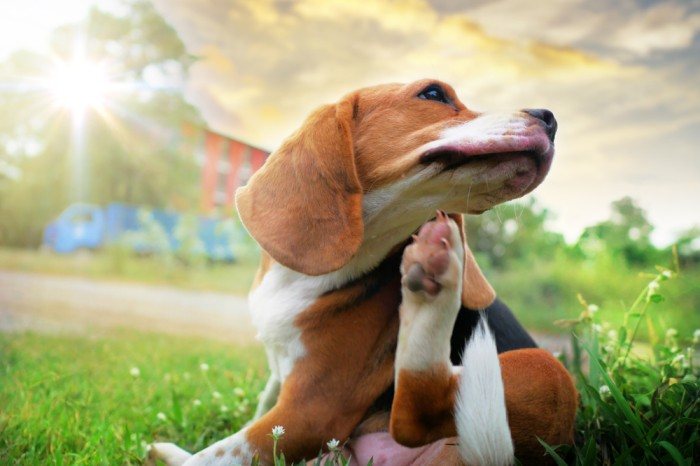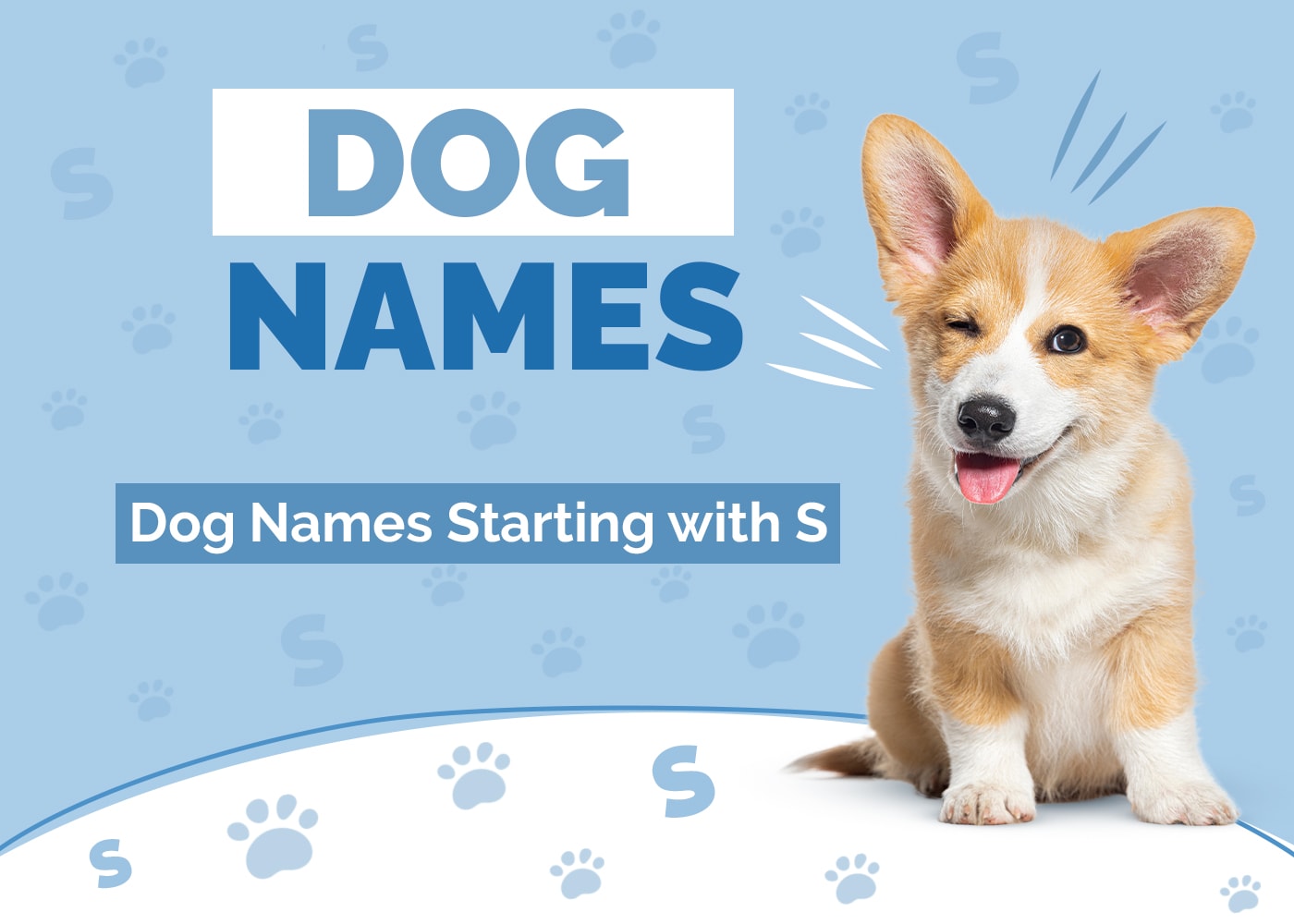Miniature vs Standard Bull Terrier: Key Differences (With Pictures)

Updated on
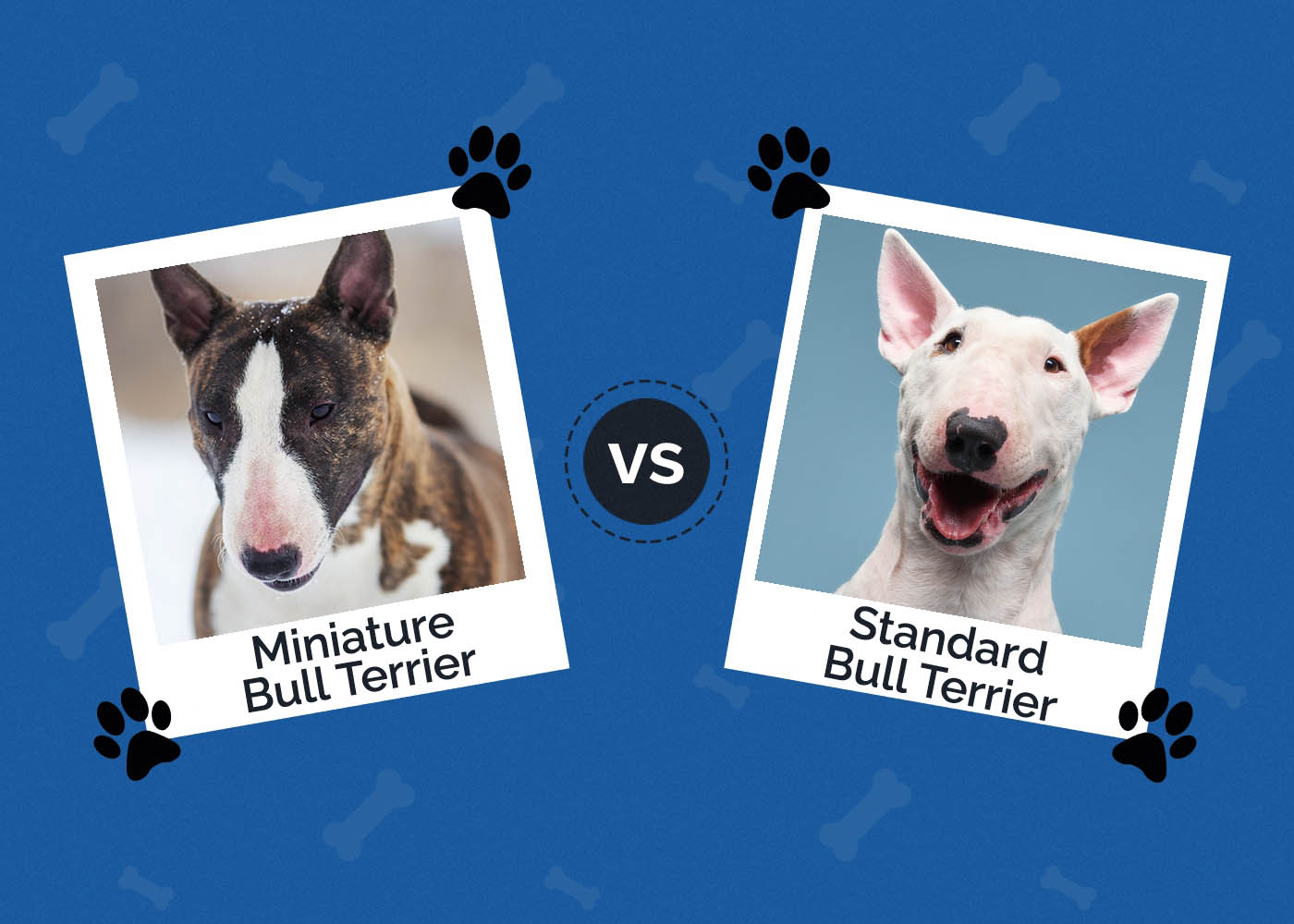
Click to Skip Ahead
Are you wanting to get a Bull Terrier and aren’t sure which one to pick between the miniature and standard variation? These two dogs may look similar, but they have distinct differences in size, personality, and health. In this comparison guide, we will take a closer look at the Miniature Bull Terrier and the Standard Bull Terrier, exploring their unique characteristics and what sets them apart. Whether you’re a seasoned dog owner or a first-time pet parent, this guide will help you make an informed decision on which dog is right for you.
Visual Differences
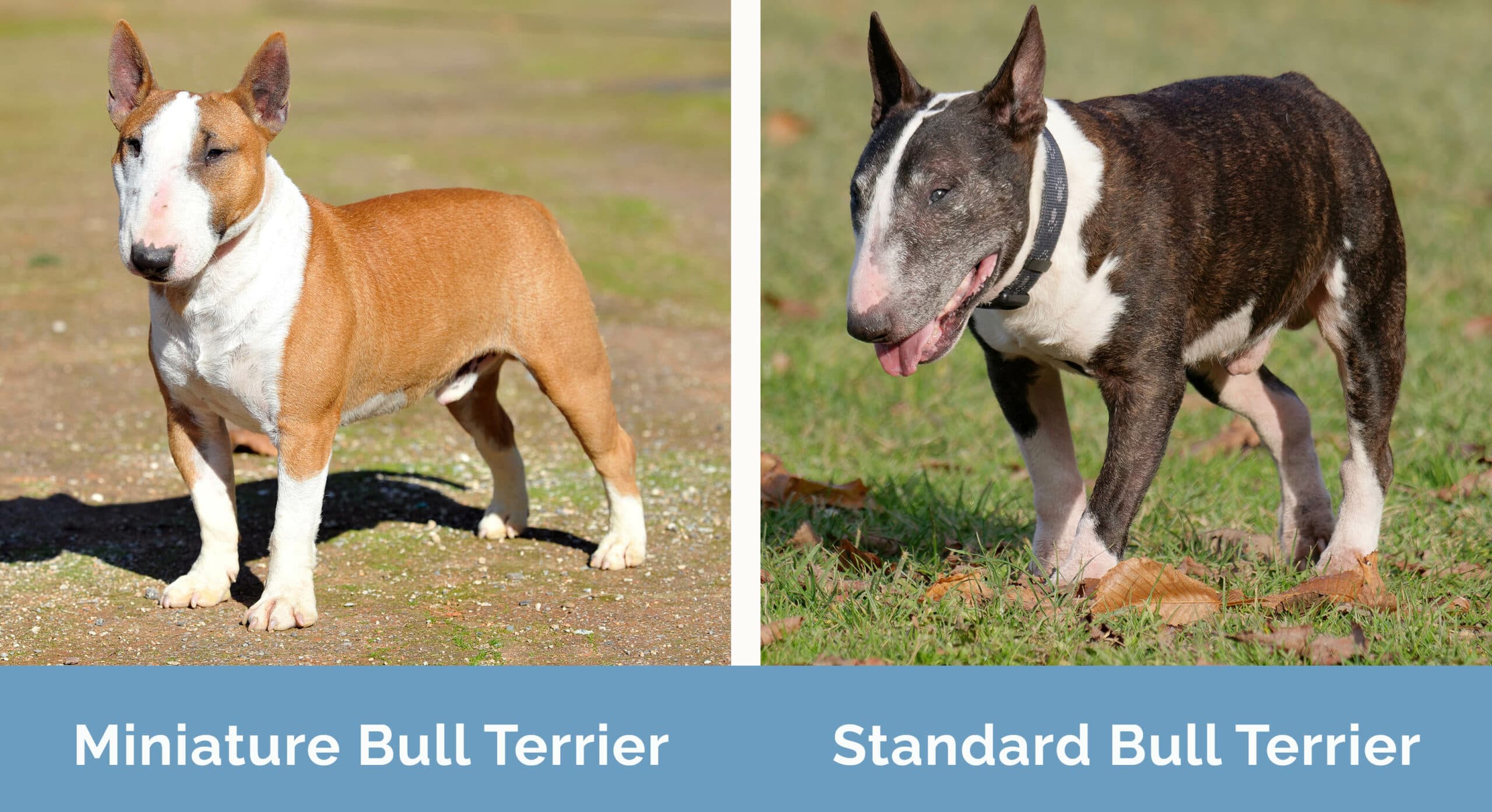
At a Glance
- Average height (adult): 10–14 inches
- Average weight (adult): 20–35 pounds
- Lifespan: 10–14 years
- Exercise: at least 30–45 minutes a day
- Grooming needs: Low
- Family-friendly: Yes
- Other pet-friendly: Often, but with caution
- Trainability: Easy
- Average height (adult): 18–22 inches
- Average weight (adult): 45–65 pounds
- Lifespan: 11–13 years
- Exercise: 1+ hours a day
- Grooming needs: Low
- Family-friendly: Yes
- Other pet-friendly: Often
- Trainability: Can be challenging
Miniature Bull Terrier Overview
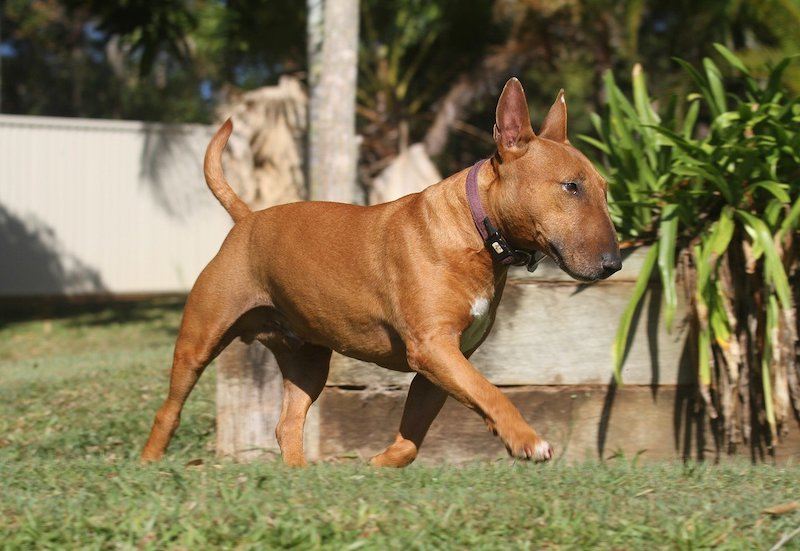
The Miniature Bull Terrier is a small breed that was developed in England in the 19th century by crossing the Bulldog and the White English Terrier. Breeders’ goals were to create a smaller version of the Bull Terrier that’d be better suited for small spaces such as apartments, but the breed gained popularity pretty fast and was recognized by the Kennel Club in England in 1939.
This terrier has a muscular build and a distinctive egg-shaped head. They’re known for their playful and affectionate nature, making them great family pets. Originally bred for bull baiting, this breed has a high prey drive and can be stubborn at times. However, with proper training and socialization (from a young age), they can make great companions.
Personality
Miniature Bull Terriers are known for their strong-willed nature, loyalty, and playfulness. These dogs love to be the center of attention and can be quite mischievous if they don’t get enough exercise and stimulation. They’re also very protective of their families and can make excellent watchdogs. And despite their small size, Miniature Bull Terriers have a lot of energy and require plenty of exercise to keep them happy and healthy. They enjoy going for walks, playing fetch, and participating in various activities with their owners.
They can also be quite stubborn at times, so training is essential to ensure that they’re well-behaved. One of the most endearing qualities of the Miniature Bull Terrier is their love for human interaction. They thrive on affection and attention from their owners and will often seek out cuddles and playtime. This is what makes them excellent family pets, as they get along well with children and other animals.
Training
These dogs are very smart and can be trained quite efficiently as long as you have the right approach. But keep in mind that every dog is different, and some may be easier to train while others may be quite challenging. But generally, these terriers respond well to positive reinforcement-based training methods. These methods involve rewarding the dog for good behavior, such as treats, toys, or praise. This type of training helps establish a positive association with the desired behavior and encourages the dog to repeat it. They’re smart dogs, so they can pick up on things quickly.
However, Miniature Bull Terriers can also be stubborn and independent-minded at times. They have a strong will and may try to test their owners’ limits during training. Consistency and patience are essential when training this breed. It’s crucial to set clear boundaries and be firm but gentle when correcting unwanted behavior. Training is definitely recommended for these dogs as well as socialization. They need exposure to different people, animals, and environments from a young age to develop good social skills. And early socialization can help prevent behavioral issues in the future and make training more manageable.

Health Concerns
These dogs are typically healthy especially if they are purchased from a solid breeder. One of the most common health issues in Miniature Bull Terriers, however, is deafness. According to the American Kennel Club, up to 20% of Miniature Bull Terriers are actually born deaf, which is much higher than in other breeds. So, it’s important for breeders to screen their dogs for deafness and for owners to be aware of the signs of deafness so they can provide appropriate care.
Another common health concern in Miniature Bull Terriers is skin allergies. These dogs have sensitive skin that can react to a wide range of outdoor and food-related allergens. To manage skin allergies, owners may need to make dietary changes, use medicated shampoos, or give their dogs allergy medications.
And lastly, these terriers are also prone to developing orthopedic issues such as patellar luxation and hip dysplasia. Patellar luxation occurs when the kneecap slips out of place and can cause pain and lameness. Hip dysplasia is a genetic condition in which the hip joint does not develop properly and can lead to arthritis and mobility issues. Regular visits to the vet can help detect these conditions early and allow for appropriate treatment.
Exercise
As a general rule, they should receive at least 30–60 minutes of exercise each day to keep these dogs in shape, prevent boredom, and to keep them from climbing your walls. This can include brisk walks, runs, playtime in a fenced yard, or interactive games such as fetch or tug-of-war.
It’s important to note that the specific exercise needs of a Miniature Bull Terrier may vary depending on their age, weight, and overall health. Puppies and senior dogs may require less exercise than adult dogs, while overweight or sedentary dogs may need more gradual increases in physical activity.
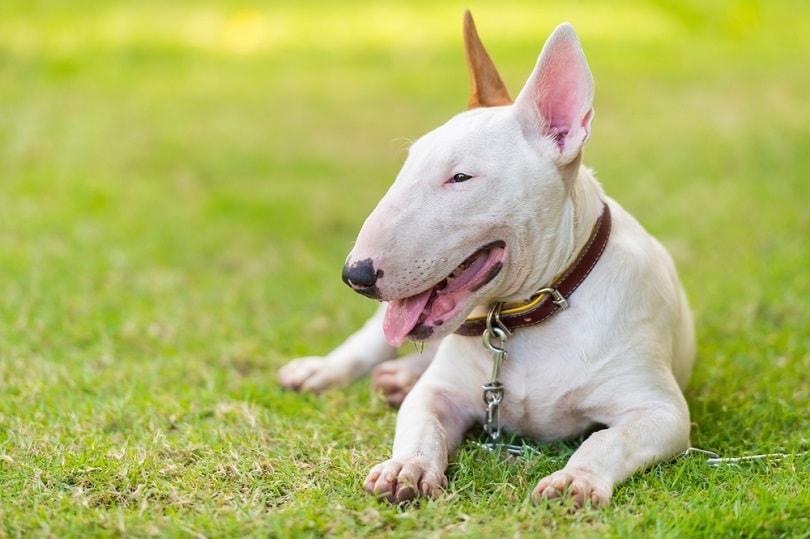
Suitable For:
These dogs are known for their energetic and playful nature, which makes them a great choice for active individuals or families with children who can provide plenty of exercise and playtime. Owners who enjoy outdoor activities such as hiking or running would be a good match for this breed. Additionally, they require consistent training and socialization to prevent any unwanted behaviors like canine aggression or excessive barking. They’re best for owners who are willing to invest time and effort into training their Miniature Bull Terrier.
Standard Bull Terrier Overview
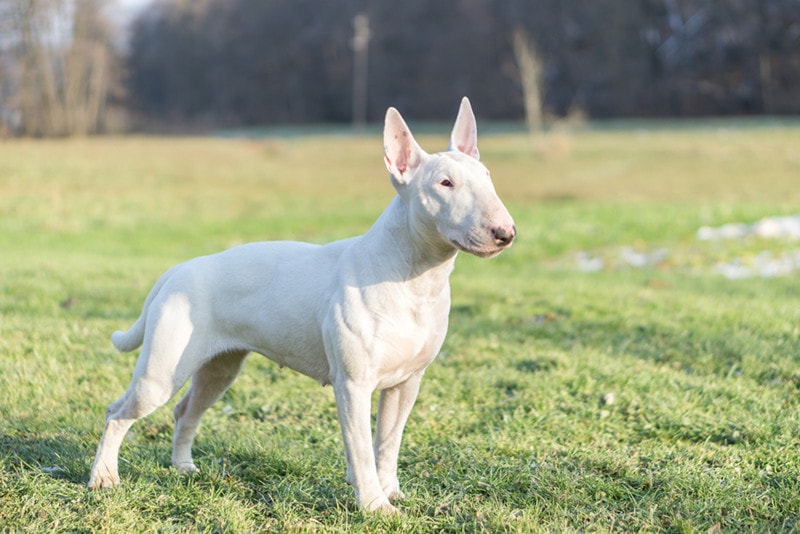
The Standard Bull Terrier originated in England around the mid-19th century. It came when breeders were looking to create a dog that combined the agility and tenacity of terriers with the strength and power of bulldogs. The result was the Bull Terrier, a breed that soon gained notoriety for its loyalty, intelligence, and athleticism. These dogs are slightly bigger than the miniature Bull Terrier and can be known for their stubborn streaks – which can make them challenging for inexperienced owners.
Personality
Like the mini terriers, these dogs are also very intelligent. But they’re also fiercely independent, with a bold and confident demeanor that can make them quite challenging to train. However, with patience, consistency, and positive reinforcement, they can excel in obedience and agility competitions. They’re also known for their love of playtime and their tendency to be rather funny dogs, often entertaining their owners with their interesting antics. They have a strong instinct to guard their loved ones and will not hesitate to defend them if they feel threatened – and their solid muscular build makes them a tad intimidating. This makes them excellent watchdogs but can also make them wary of strangers.
Training
These dogs should definitely begin training when they are young puppies, but they can be a bit challenging due to their stubbornness and independent nature. It’s best to train these dogs on a set schedule every day for several months. You’ll need to understand your terrier’s personality in order to gain patience and persistence with training – it’s all about the right approach. Keep in mind that these are bulldogs so it’s best to train them when they’re young, to prevent them giving in to their canine instincts and, as a result, becoming dangerous as adults.
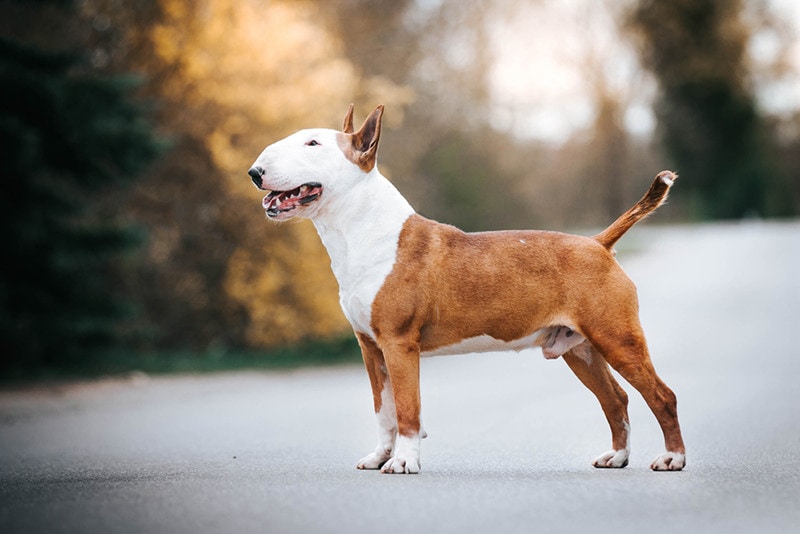
Health Concerns
While these are generally healthy dogs, there are a few health conditions that are more common in this breed than others. A common health condition seen in these terriers is skin allergies. These dogs have sensitive skin that can become irritated by a variety of environmental factors, such as pollen, dust, and certain types of food. Signs of skin allergies may include itching, redness, and scaly patches on the skin. Treatment typically involves identifying and removing the allergen, as well as using medicated shampoos or creams to soothe the skin. They’re also prone to hip dysplasia and cherry eye. Cherry eye occurs when the gland that produces tears becomes inflamed and protrudes from the eye. This can cause discomfort and interfere with vision. Treatment typically involves surgery to remove the gland.
Standard Bull Terriers are also prone to heart problems such as mitral valve disease. This is a condition in which the valve between the left atrium and ventricle becomes damaged and doesn’t function properly. Signs may include coughing, difficulty breathing, and lethargy. Treatment may involve medication to manage symptoms, but in severe cases, surgery may be necessary.
Exercise
These dogs are high-energy and require at least an hour of physical activity every single day. This can include brisk walks, jogging, running, playing fetch, and other activities that get them moving and burn off their excess energy. It’s important to note that every dog is different, and their exercise needs may vary depending on their age, weight, health condition, and overall temperament. Some Bull Terriers may require more exercise than others, while some may be okay with a moderate amount of activity.
Regular exercise not only helps your Bull Terrier stay physically fit but also helps them release pent-up energy and reduce stress. It can also prevent behavioral issues like boredom, restlessness, and destructive chewing – after all, they are bulldogs. However, it’s equally important not to over-exercise your dog. Too much physical activity can lead to exhaustion, dehydration, and even injury. So be sure to provide your pup with plenty of water breaks during exercise sessions and avoid exercising them in hot or dry weather conditions.
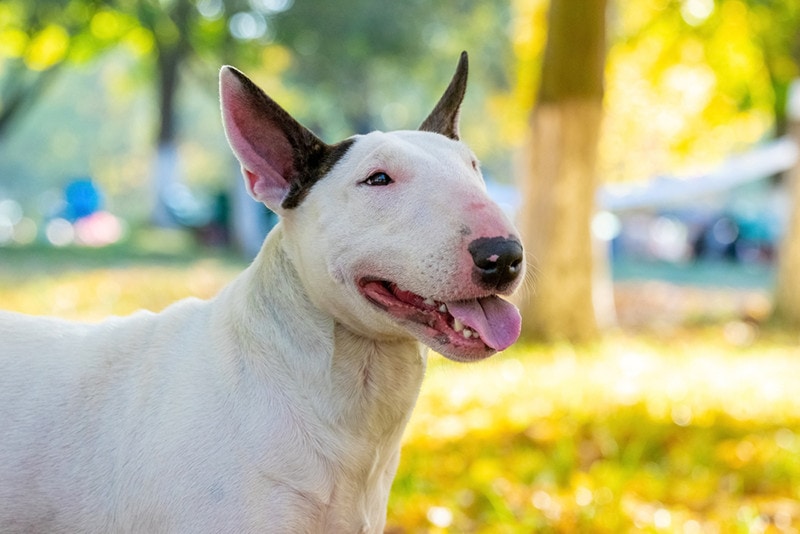
Suitable For:
Overall, Bull Terriers are best suited for owners who are willing to put in the time and effort to train and care for them properly. They need lots of mental stimulation and plenty of daily exercise. Bull Terriers can be stubborn at times, so an owner who is firm but gentle will have the best results. They do well with positive reinforcement training methods and respond well to praise and treats. This breed isn’t recommended for first-time dog owners or those who cannot commit to the time and energy required.
Which Breed Is Right for You?
While both breeds share many similarities, there are a few key differences to keep in mind. Miniature bullies are smaller in size, typically weighing between 20–35 pounds, while Standard Bull Terriers can weigh up to 80 pounds – they’re closer to Pit Bulls in size and stature. This means that Miniatures may be better suited for apartment living or for those who prefer a smaller dog.
Another factor to consider is personality. Both breeds are known for being friendly and affectionate with their families but can be stubborn and independent at times. Miniatures may be a bit easier to train due to their smaller size and lower energy level, but both breeds require consistent training and socialization from an early age. Ultimately, the decision of which breed is right for you will depend on your individual lifestyle, preference, and time.
Featured Image Credit: (L) Daria Shvetcova, Shutterstock | (R) dezy, Shutterstock



